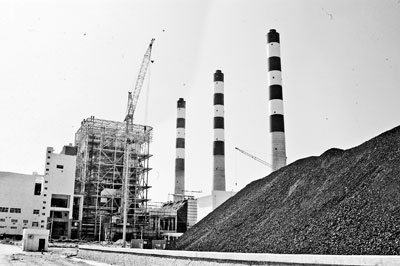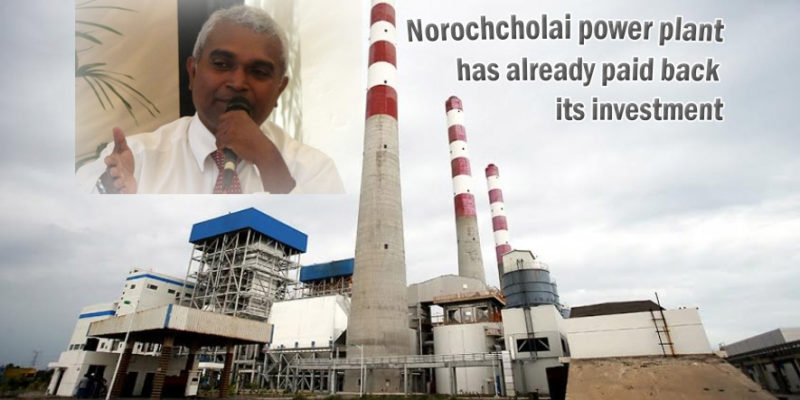One day possibly in April 2014, the President called the Minister of Power and Energy to meet her. He rushed to Temple Trees with his deputy, to be told that she would have no objection to the Ministry proceeding with the Norochcholai coal power project. The Minister and his deputy were astonished; they could not believe their ears, since for 11 years, their own President, much of the government and the opposition too, stated through dozens of decisions and Cabinet memos, that the Norochcholai power plant would not be built.

The Minister and his deputy came out of the President’s office, conferred among themselves for a while outside, and went back in, to double check with the President, what they heard from her minutes ago. And she confirmed it for the second time and possibly shouted out: go and do it! The pleas of electricity planners were brushed aside for over two decades, and politics took precedence. Two bad spells of power cuts had crippled the economy.
http://www.sundaytimes.lk/170709/business-times/feature-norochcholai-power-plant-has-already-paid-back-its-investment-248990.html
By this time, the offered Japanese technical assistance to build Sri Lanka’s first coal-fired power plant to Japanese standards using Japanese technology was gone, thanks to the government of 2002 that gave marching orders to the Japanese, and ordered more and more diesel power plants. Meanwhile, the friends of the government, just as they do today, were queuing up at the Prime Minister’s office offering diesel power plants.
Remember, no coal means more diesel, and you – as customers – pay. To a country that had bungled its decision-making process on power projects, and by the time the correct decision was arrived at in 2004, it was too late. The friends of the country had already been chased away by the government of 2001-2004, by then in opposition. Divide CEB into six, sell it off, and then we will assist you to build power plants, said some multilateral lending agencies. When the country was bleeding with blackouts and heavy expenditure on diesel, they thought selling off CEB was the priority. No other country was willing to lend and assist; China was the only option, with all the pain that finally came with it.
The rest is history. The Norochcholai power plant was built at an all-inclusive cost of US$1,342 million inclusive of transmission lines and coal unloading jetty, the country’s largest ever single investment on a project. The work was completed in three stages. Year 2015 was the first full calendar year of operation. The full power plant has now operated for at least two years and six months. The power plant went down many times over in 2014-2015, usual for a new power plant in its first year, but subsequent outages over 2015 are certainly in excess of the worldwide norm.
So by April 2017, the coal power plant has produced about 18,300 million units of electricity. Leaving a 10 per cent margin for in-house use and transmission loss, energy delivered would be about 16,470 GWh. Norochcholai produced this electricity at an average cost of Rs. 5 per unit, and saved electricity produced at least at Rs. 17 per unit. Therefore, the savings are $1,300 million from the time Norochcholai began operations to the present.
So, some day in June 2017, the country fully recovered the money paid for Norochcholai by way of savings in the fuel bill. Even if no one appreciates, those who watch the balance of payments at the Treasury will know exactly the benefit of the power plant to the economy. The fuel (oil, gas and coal) import bill that was 26 per cent of imports in 2012, has since declined to 14 per cent by 2015, and 13 per cent by 2016. The Treasury must be feeling the figures to be cool, given that the country is in a severe crisis to pay the loans for non-performing ports and airports. The investment for Norochcholai has already been recovered in less than three years (see Sunday Times, 20th March 2011), but its loans must be repaid over 10 to 20 years.
Isn’t that itself a benefit, to an economy starved of cash?
Just like any other country, some such as Japan, Germany and Denmark, and even India and China, Sri Lanka too now gets a sizeable share of its electricity from its coal-fired power plant. Before coal power came in, Sri Lanka’s electricity average cost to customer went up to Rs. 23 and went down to Rs. 16 per kWh in 2015, the first full year of the coal power plant’s operation. A reduction of 30 per cent.
In 2015, the share of electricity produced from coal was as follows: Sri Lanka: 34 per cent, world average 41 per cent. For hydro and renewables, see where we are: Sri Lanka: 48 per cent, world average: 23 per cent. So, are we the “bad guy” in the world. No!
Statistics can be presented for hours and hours, which all show that Sri Lanka in 2015, was doing a lot better than almost all developed countries in renewable energy development, but would not build diesel power plants, but coal and renewables. Coal will keep the electricity supply stable, technically and economically. Renewables would keep the green objectives intact, and in some cases, would fulfil economic objectives as well.
However, textbook, political and Internet specialists on environment, and much of the media, say one thing in unison: the world is moving away from coal (which is not the case, but yes, a lot of publicity is given to shutting down of coal power plants, and nothing is given out by the respective national security agencies, about how many are started up each year). No, the world is not moving away, but consolidating and cautiously managing the fuel mix in power generation. After all, these are countries who have their national security at the highest level. Even if engineers want something else, even if environmental lobbyists want renewables and nothing else, the national security would not allow shutting down of power plants.
It is wrong to assume, and lie around, that the whole world is running for and running on renewable energy. No, it is only in Sri Lanka, that the Public Utilities Commission and certain elements of the Government, keep ordering CEB to build diesel power plants and renewables, and nothing else.
Diesel kills the economy of electricity supply, renewables contribute when they can, but in rain and if off-season, wind and solar PV are of no value. Impacts are many. Governments and electricity utilities such as CEB exist because they have to use fuels difficult to handle, produce electricity, keep back-up capacity, and then deliver a reliable, lower cost product to the customer. If they too produce electricity the same way you too can do (diesel generator) or with the same solar panels which you too could fix on your roof, then there is no need for CEB. You can do it yourselves but face the consequences. There is no compulsion: any environmental enthusiast can go off grid, do everything with solar; do not buy from CEB because they use coal power. Ask CEB (or LECO) to cut off your supply.
When difficult fuels are handled, there will be consequences, and they have to be handled properly, with the required expertise and care. Norochcholai had problems related to ash management; the fault of a system or one mishap is no reason to throw away a benefit of $500 million per year and a stable electricity supply. All engineering problems have a solution, but there will be a price to be paid. If the price is right, then more environmental management systems have to be implemented and the country should proceed with more of the same technology, but absorbing technological improvements as we proceed.
Already in 2017 January to April, Sri Lanka has spent $160 million extra on petroleum fuels (diesels, fuel oil, etc) compared with the long-term plan of 2009. Why? The government will say it is the drought, but the real reason is that the Sampur coal power plant scheduled for 2016 was not built and may perhaps never be built. Happily, pay the extra fuel cost. You customers are actually paying for this diesel, right now, in your bill. Why? Because if Sampur was allowed to be built, your electricity bill would have been lower.
Now that is the beauty of a paradise.
So remember again, no coal means more diesel and you customers already pay for the missing Sampur power plant. Many think that no coal means renewables. Wrong!
If you do not believe it go to Galle, Hambantota, Kurunegala and Pallekelle substations. How you identify a major substation is when you see tall power lines ending there, and starting off from there, and you see tall structures. The name board says “Grid Substation”.
Watch the diesel bowsers going into nearby yards, many a day; listen to the hum of the diesel engines. Do you hear them? That’s it. You have found it. Producing electricity at three times the cost of Norochcholai and (the now stalled) Sampur. That’s how your Government works to uplift the ailing economy.
By Dr. Tilak Siyambalapitiya
Sunday Times – Sunday, July 09, 2017
http://www.sundaytimes.lk/170709/business-times/feature-norochcholai-power-plant-has-already-paid-back-its-investment-248990.html

